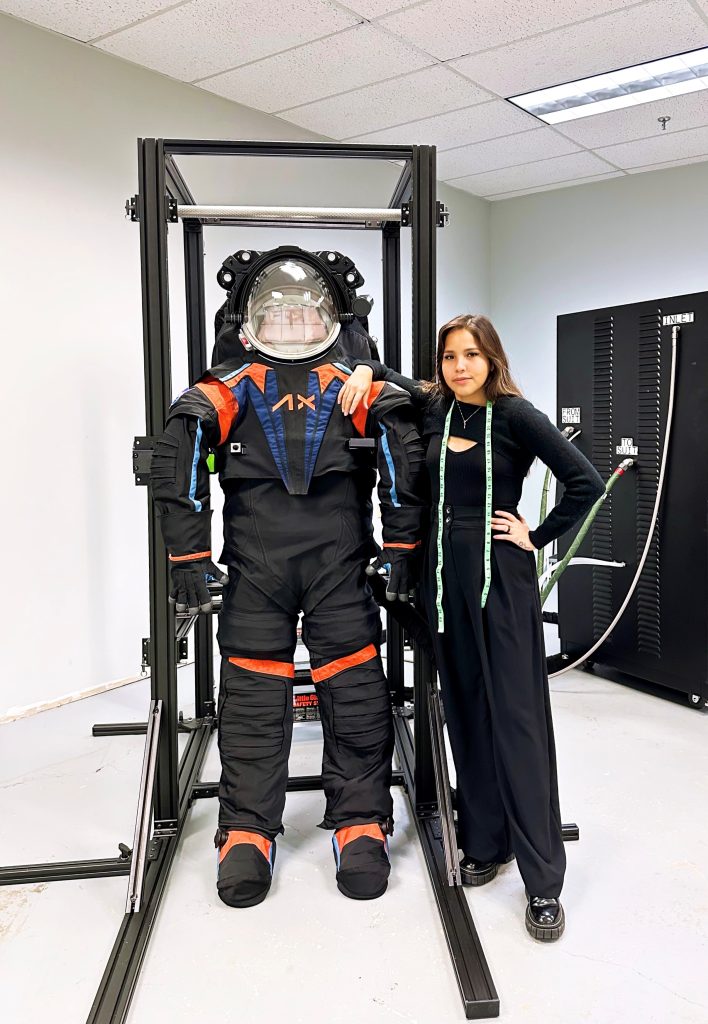
Pamela Cooper, BFA Fashion Design ’18, is Designing the Next Generation of Space Suits
When thinking of space travel, it’s easy to conjure notions of high-tech ships manned by genius astronauts on their way to discover something new and exciting. And while all of that may be true, there has been very little innovation in the design of the spacesuit that astronauts wear in the 40 years since the Exterior Mobility Unit (EMU) utilized by the International Space Station was introduced.
In the past few years, Axiom Space has begun developing new space suits for the Artemis mission, where Pamela Cooper, BFA Fashion Design ‘18, serves as an Environmental Protective Garment (EPG) Design Lead. In her role, Cooper designs and oversees production of the entire garment layer, spanning several disciplines including engineering, technical writing, and sewing production.
“Shortly after moving from New York to Texas, I took a trip to Space Center Houston and saw the spacesuits on display,” shares Cooper. “I was so fascinated by the suits that I researched the history of how they were made. I primarily focused on the part that cooled the person inside the suit, the Liquid Cooling and Ventilation Garment (LCVG), since at the time I was developing a wearable technology cooling compression vest. From there, I became obsessed with researching different space companies to see if they were working on a spacesuit. Fortunately, I found that Axiom Space was developing spacesuits for the Artemis missions and was looking for people to join their team.”
The spacesuit Cooper is developing will be worn by the first female and first person of color to walk on the moon, and will be a vast improvement over the original EMU suit. Historically, spacesuits were custom designed for individual astronauts, but now they have a modular architecture that allows for several sizes, as well as elements that can be modified once the astronauts are in space.
“My current role allows me to be a part of something that will help further humanity,” explains Cooper. “Being part of a team with so much expertise and passion has further ignited my own fascination for wearable technology. Under my current mentorship, my mentality and approach on how I design has improved and grown tremendously. Everyday there’s new things to learn and I am so glad to be a part of making history.”


During her time at Parsons, Cooper was given the opportunity to not only take traditional design classes, but courses that expanded her perspective and idea of what design can do, and how it can help others. A class on designing for disabilities shifted her thinking from “how can I create beautiful clothing?” to “how can clothing help someone?” which ultimately led her to join a New School hackathon for healthcare, where she won first place.
“After that competition, I became obsessed with mixing technology, healthcare, and fashion into one,” says Cooper. “My thesis was centered around wearable tech that can help people with neurological differences. I made a compression vest that automatically compressed when the wearer was stressed, sound muffling hats to help with noise stimulation, sensory jewelry that hit different pressure points on the body to calm people, and more. Once my thesis was finished, I kept pursuing the compression vest I invented and eventually got a patent on my design. This led to me starting my wearable company and joining Parsons Elab program which helped me grow not only as a designer but as a businessperson as well.”
Cooper is not the only member of the Parsons community using the power of design for social good. Lani Adeoye, AAS Interior Design ’14 and a faculty member at Parsons, is reframing West African heritage through design for a global audience, while David Gissen, Professor of Architecture at Parsons, recently debuted a new book about disability in design.
An integral part of the mission and vision of a Parsons education is that design can be used to create positive social change, which aligns with Cooper’s motivations as a designer.
“As a solution-based designer; my goal is to make clothing functional, accessible, and fashionable for all,” she shares. “Design should not only look good but aid the wearer on a day-to-day basis. This translates well into my role as I am constantly learning user feedback and implementing it into my design. I aim to tackle a lot of problems with my designs – like inclusivity with sizes, gender and accessibility for an easier donning and doffing usability.”